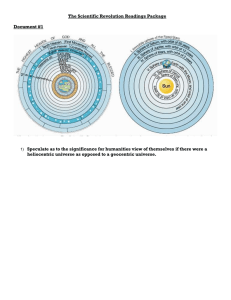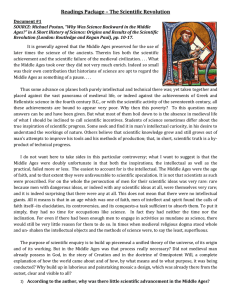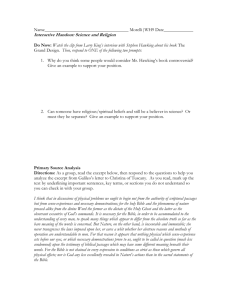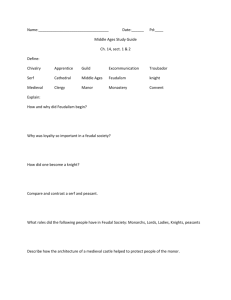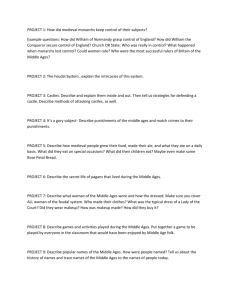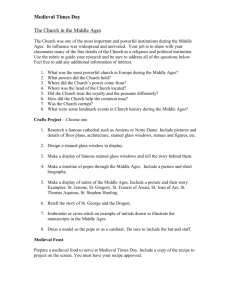NAME Scientific Revolution – Document Packet #1
advertisement
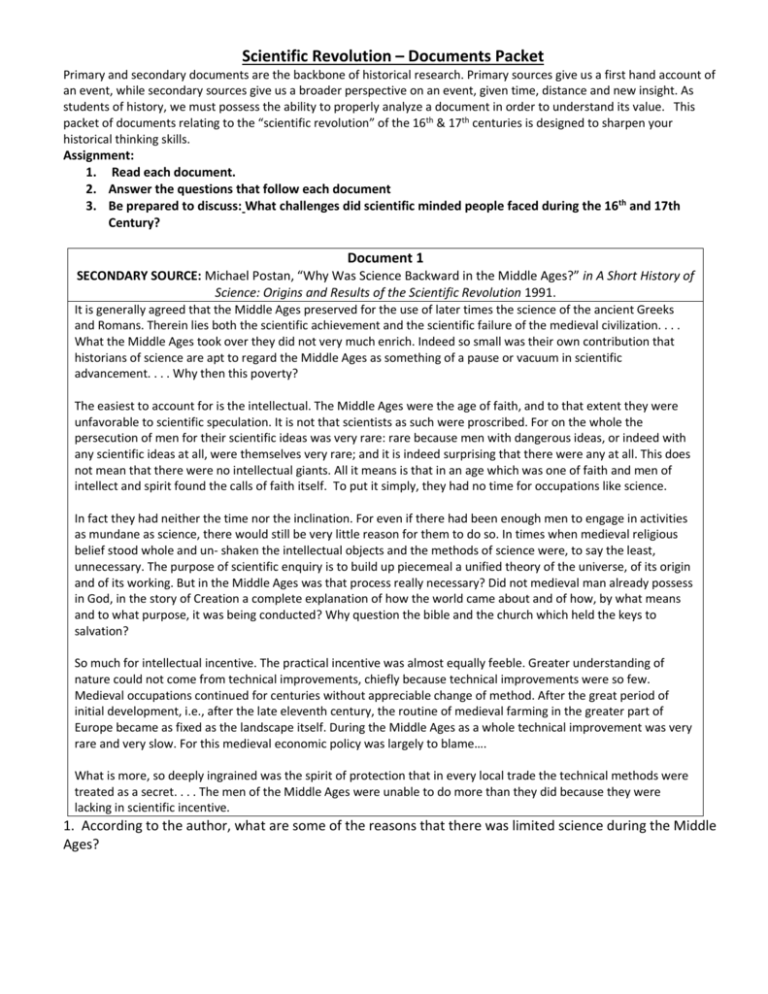
Scientific Revolution – Documents Packet Primary and secondary documents are the backbone of historical research. Primary sources give us a first hand account of an event, while secondary sources give us a broader perspective on an event, given time, distance and new insight. As students of history, we must possess the ability to properly analyze a document in order to understand its value. This packet of documents relating to the “scientific revolution” of the 16th & 17th centuries is designed to sharpen your historical thinking skills. Assignment: 1. Read each document. 2. Answer the questions that follow each document 3. Be prepared to discuss: What challenges did scientific minded people faced during the 16th and 17th Century? Document 1 SECONDARY SOURCE: Michael Postan, “Why Was Science Backward in the Middle Ages?” in A Short History of Science: Origins and Results of the Scientific Revolution 1991. It is generally agreed that the Middle Ages preserved for the use of later times the science of the ancient Greeks and Romans. Therein lies both the scientific achievement and the scientific failure of the medieval civilization. . . . What the Middle Ages took over they did not very much enrich. Indeed so small was their own contribution that historians of science are apt to regard the Middle Ages as something of a pause or vacuum in scientific advancement. . . . Why then this poverty? The easiest to account for is the intellectual. The Middle Ages were the age of faith, and to that extent they were unfavorable to scientific speculation. It is not that scientists as such were proscribed. For on the whole the persecution of men for their scientific ideas was very rare: rare because men with dangerous ideas, or indeed with any scientific ideas at all, were themselves very rare; and it is indeed surprising that there were any at all. This does not mean that there were no intellectual giants. All it means is that in an age which was one of faith and men of intellect and spirit found the calls of faith itself. To put it simply, they had no time for occupations like science. In fact they had neither the time nor the inclination. For even if there had been enough men to engage in activities as mundane as science, there would still be very little reason for them to do so. In times when medieval religious belief stood whole and un- shaken the intellectual objects and the methods of science were, to say the least, unnecessary. The purpose of scientific enquiry is to build up piecemeal a unified theory of the universe, of its origin and of its working. But in the Middle Ages was that process really necessary? Did not medieval man already possess in God, in the story of Creation a complete explanation of how the world came about and of how, by what means and to what purpose, it was being conducted? Why question the bible and the church which held the keys to salvation? So much for intellectual incentive. The practical incentive was almost equally feeble. Greater understanding of nature could not come from technical improvements, chiefly because technical improvements were so few. Medieval occupations continued for centuries without appreciable change of method. After the great period of initial development, i.e., after the late eleventh century, the routine of medieval farming in the greater part of Europe became as fixed as the landscape itself. During the Middle Ages as a whole technical improvement was very rare and very slow. For this medieval economic policy was largely to blame…. What is more, so deeply ingrained was the spirit of protection that in every local trade the technical methods were treated as a secret. . . . The men of the Middle Ages were unable to do more than they did because they were lacking in scientific incentive. 1. According to the author, what are some of the reasons that there was limited science during the Middle Ages? Document 2 SECONDARY SOURCE: Sir George Clark, Early Modern Europe. 1982. There were an infinite number of motives which led men to engage in scientific work beginning around the 16th Century at about the same time as the “renaissance” and to encourage the scientific point of view. We may group together some of the most important under general headings, always remembering that in actual life each of them was compounded and influenced by the others. There were economic motives. The Portuguese explorers wanted their new instrument for navigation; the German mine-owners asked questions about metallurgy and machines for lifting and carrying heavy loads; Italian engineers improved their canals and locks and harbors by applying the principles of hydrostatics; English trading companies employed experts who used new methods of drawing charts. Not far removed from the economic motives were those of the physicians and surgeons, who revolutionized anatomy and physiology, and did much more good than harm with their new medicines and new operations, though some of them now seem absurd. Like the doctors, the soldiers called science to their aid in designing and aiming artillery or in planning fortifications. But there were other motives far removed from the economic sphere. Jewelers learnt much about precious and semi-precious stones, but so did magicians. Musicians learnt the mathematics of harmony; painters and architects studied light and color, substances and proportions, not only as craftsmen but as artists. For a number of reasons religion impelled men to scientific study. The most definite and old-established was the desire to reach absolute correctness in calculating the dates for the annual fixed and movable festivals of the Church: it was a pope who presided over the astronomical researchers by which the calendar was reformed in the 16th century.… For many reasons, deeper and stronger was the desire to study the wonders of science across Europe, and the order which it unraveled in the universe, as manifestations of the Creator's will by around 1600. 2. Sir George Clark focuses on the motivations for people to study science in the 16 th Century. Summarize these motives and explain the connection of these motives to the ideals of the Renaissance. Document 3 PRIMARY SOURCE Left – Geocentric model of the universe as first described by Ptolemy (90-168 AD). Right – Heliocentric model of the universe as first described by Copernicus (1473-1543) 3. Explain Copernicus’ view of the universe and explain why this view of the universe may have been controversial during this time period (1530’s). Document 4 PRIMARY SOURCE: A Letter to Christina of Tuscany from Galileo Galilei, 1615. I think that in discussions of physical problems we ought to begin not from the authority of scriptural passages, but from sense-experiences and necessary demonstrations; for the holy Bible and the phenomena of nature proceed alike from the divine Word. It is necessary for the Bible, in order to be understood by the average man, to speak many things which appear to differ from the absolute truth so far as the bare meaning of the words is concerned. But Nature, on the other hand, is inexorable and immutable and never transgresses the laws imposed upon her, or cares whether reason and method of operation are understandable to men… For that reason it appears that nothing physical which sense-experience sets before our eyes, or which necessary demonstrations prove to us, ought to be called in question (much less condemned) upon the testimony of biblical passages which may have some different meaning beneath their words. For the Bible is not chained in every expression to conditions as strict as those which govern all physical effects; nor is God any less excellently revealed in Nature's actions than in the sacred statements of the Bible. . . . The Bible shows the way to go to heaven, not the way the heavens go. From this I do not mean to infer that we need not have an extraordinary esteem for the passages of Holy Scripture. On the contrary, having arrived at any certainties in physics, we ought to utilize these as the most appropriate aids in the true meaning of the Bible and in the investigation of those meanings which are necessarily contained therein, for these must be understood with demonstrated truths. I should judge that the authority of the Bible was designed to persuade men of those beleifs and propositions which, surpassing all human reasoning, could not be made credible by science, or by any other means than through the very mouth of the Holy Spirit. Yet even in those propositions which are not matters of faith, Biblical authority ought to be preferred over that of all human writings which are supported only by bare assertions or opinions, and not set forth in a demonstrative way. This I hold to be necessary and proper to the same extent that divine wisdom surpasses all human judgment and conjecture… I do not feel obliged to believe that that same God who has endowed us with senses, reason, and intellect has intended all humanity to forgo their use and by some other means to give us knowledge. 4. According to Galileo, what is the proper relationship between scripture and science? 5. How does he use religious beliefs to support the work of science? How is this connected to the ideals of the Renaissance? 6. Galileo was both a scientist and a devoutly religious man. How do both of those beliefs shape his point of view about this issue? Document 5 PRIMARY SOURCE: The Papal Inquisition’s condemnation of Galileo, 1633. We say, pronounce, sentence, and declare that you. the said Galileo, by reason of the matters discussed in trial, and by your confession as you rendered, are in the' judgment of this Holy Office vehemently suspected of heresy, namely, of having believed and held the doctrine-which is false and contrary to the sacred and divine Scriptures--that the Sun is the center of the world and does not move from east to west and that the Earth moves and is not the center of the world… Furthermore, your opinion has been declared and defined to be contrary to the Holy Scripture; and that consequently you have incurred all the censures and penalties imposed and stated in the sacred laws of the Church, for [breaking] this sacred law... From which we are content that you be absolved, provided that, first, with a sincere heart and unfeigned faith, you renounce, curse, and detest before us the aforesaid errors and heresies and every other error and heresy contrary to the Catholic and Apostolic Roman Church in the form to be prescribed by us for you. 7. Explain why the Catholic Church might condemn Galileo for his scientific practices and beliefs? 8. Explain how the Catholic Church is biased in their beliefs towards the work of Galileo and other scientists. Document 6 PRIMARY SOURCE Isaac Newton, The Mathematical Principles of Natural Philosophy, 1729. RULE 1 We are to admit no more causes of natural things, than such as are both true and sufficient to explain their appearances. To this purpose the philosophers say, that Nature does nothing in vain, and more is in vain, when less will serve; for Nature is pleased with simplicity, and affects not the pomp of superfluous causes. RULE II Therefore to the same natural effects we must, as far as possible, assign the same causes. As to respiration in a man, and in a beast; the descent of stones in Europe and in America; the light of`our culinary fire and of the sun; the reflection of light in the earth, and in the planets RULE III The qualities of bodies, which admit neither intension nor remission of degrees, and which are found to belong to all bodies within reach of our experiments, are to be esteemed the universal qualities of all bodies whatsoever. For since the qualities of bodies are only known to us by experiments, we are to hold for universal, all such as universally agree with experiments. We are certainly not to relinquish the evidence of experiments for the sake of dreams and vain fictions of our own devising….Lastly, if it universally appears, by experiments and astronomical observations, that all bodies about the earth, gravitate toward the earth; and that in proportion to the quantity of matter which they severally contain; that the moon likewise, according to the quantity of its matter, gravitates toward the earth; that on the other hand our sea gravitates toward the moon; and all the planets mutually one toward another; we must, in consequence of this rule, universally allow, that all bodies whatsoever are endowed with a principle of mutual gravitation. I affirm gravity to be essential to all bodies. By their inherent force I mean nothing but their force of` inertia. This is immutable. RULE IV In experimental philosophy we are to look upon propositions collected by general induction from phenomena as accurately or very nearly true, notwithstanding any contrary hypotheses that may be imagined, till such time as other phenomena occur, by which they may either be made more accurate, or liable to exceptions. This rule we must follow that the argument of experimentation and evidence may not be evaded by hypotheses. How can you relate Newtons’ laws to Renaissance ideals/thinking?
